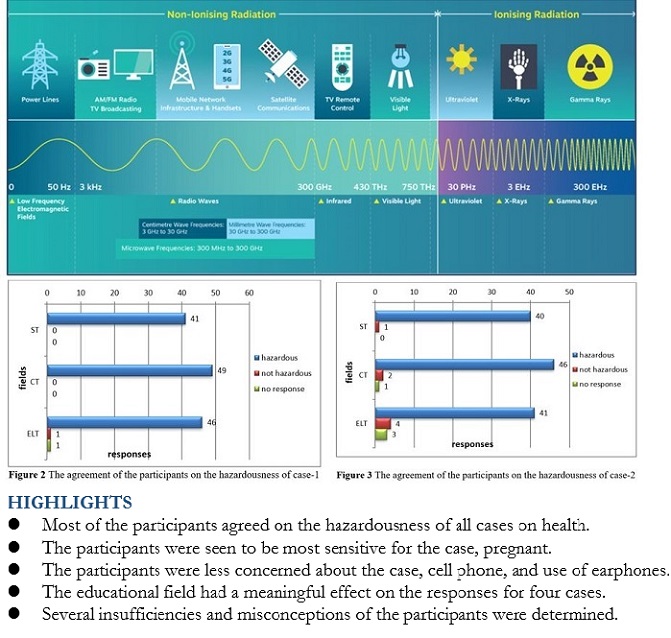
Awareness of Turkish Pre-Service Teachers about the Risks of Electromagnetic Radiation in Daily Life Cases
Abstract
Full Text:
DOWNLOAD PDFReferences
Acar Şeşen, B., & İnce, E. (2010). Internet as a source of misconception: “radiation and radioactivity”. TOJET: The Turkish Online Journal of Educational Technology, 9(4), 94-100.
Alsop, S. (2001). Living with and learning about radioactivity: A comparative conceptual study. International Journal of Science Education, 23(3), 263-281. DOI: 10.1080/095006901750066510.
Andres, L. (2012). Designing and Doing Survey Research. London: Sage.
Brod, M., Tesler, L.E., & Christensen, T.L. (2009). Qualitative research and content validity: developing best practices based on science and experience. Quality of Life Research 18, 1263–1278. DOI: 10.1007/s11136-009-9540-9.
Cardoso, P.S.S., Nunes, M.C.S., Silva, G.P.S., Braghittoni, L.S., & Trindade N.M. (2020). Conceptions of high school students on atomic models, radiation and radioactivity. Physics Education, 55(3), 1-8.
Crain-Dorough, M. (2019). Considering the source: Sampling and data collection in a mixed methods study. In M.L. Baran & J.E. Jones (Eds.), Applied Social Science Approaches to Mixed Methods Research (pp. 54-85). Hersey, PA: IGI Global.
Colclough, N.D., Lock, R., & Soares, A. (2011). Pre‐service teachers’ subject knowledge of and attitudes about radioactivity and ionizing radiation. International Journal of Science Education, 33(3), 423-446. DOI: 10.1080/09500691003639905.
Dolu, G., & Ürek, H. (2015). Are graduate students sufficiently aware of “environmental and electromagnetic pollution”?. Necatibey Faculty of Education Electronic Journal of Science and Mathematics Education, 9(1), 165-183.
Gandhi, O.P., Morgan, L.L., Augusto de Salles, A., Han, Y.-Y., Herberman, R.B., & Davis, D.L. (2012). Exposure limits: The underestimation of absorbed cellphone radiation, especially in children. Electromagnetic Biology and Medicine, 31(1), 34-51. DOI: 10.3109/15368378.2011.622827.
Gilman, E.A., Kneale, G.W., Knox, E.G., & Stewart, A.M. (1988) Pregnancy x-rays and childhood cancers: effects of exposure age and radiation dose. Journal of Radiological Protection, 8(1), 3-8.
Gorpinchenko, I., Nikitin, O., Banyra, O., & Shulyak, A. (2014). The influence of direct mobile phone radiation on sperm quality. Central European Journal of Urology, 67(4), 65-71. DOI: 10.5173/ceju.2014.01.art14.
Henriksen, E.K., & Jorde, D. (2001). High school students’ understanding of radiation and the environment: Can museums play a role?. In L.D. Dierking & J.H. Falk (Eds.), Informal Science (pp.189–206), 85, John Wiley & Sons, Inc.: Science Education.
Kada, S. (2017). Awareness and knowledge of radiation dose and associated risks among final year medical students in Norway. Insights Imaging, 8(6), 599–605. DOI: 10.1007/s13244-017-0569-y.
Lu, Y., & Huang, Y. (2012). Biological effects of mobile phone radiation. In IEEE International Conference on Microwave and Millimeter Wave Technology (ICMMT), Shenzhen, China, 5-8 May, pp.1-4. DOI: 10.1109/ICMMT.2012.6230101
Miles, M.B., & Huberman, A.M. (1994). Qualitative data analysis an expanded sourcebook. California: Sage.
Mubeen, S.M., Abbas, Q., & Nighat Nisar, N. (2008). Knowledge about ionising and non-ionising radiation among medical students. Journal of Ayub Medical College Abbottabad, 20(1), 118-121.
Neumann, S., & Hopf, M. (2012). Students’ conceptions about ‘radiation’: Results from an explorative interview study of 9th grade students. Journal of Science Education and Technology, 21(6), 826–834. DOI: 10.1007/s10956-012-9369-9.
O’Sullivan, J., O’Connor, O.J., O’Regan, K., Clarke, B., Burgoyne, L.N., Ryan, M.F., & Maher, M.M. (2010). An assessment of medical students’ awareness of radiation exposures associated with diagnostic imaging investigations. Insights Imaging, 1(2), 86–92. DOI: 10.1007/s13244-010-0009-8.
Otsuji, H., Toda, M., Nobeoka, A., & Taylor, P.C.S. (2014). The developed inquiry-based spiral curriculum to promote the radiation literacy as STS and Sustainability Education. In STEM 2014 Conference, Vancouver, Canada, 12-15 July, pp.1-5.
Plotz, T., & Hopf, M. (2016). Students misconceptions about invisible radiation. In J. Lavonen, K. Juuti, J. Lampiselkä, A. Uitto & K. Hahl (Eds.), Electronic Proceedings of the ESERA 2015 Conference. Science education research: Engaging learners for a sustainable future, Part 1 (co-ed. O. Finlayson & R. Pinto), (pp. 95-100). Helsinki, Finland: University of Helsinki.
Prather, E.E., & Harrington, R.R. (2001). Student understanding of ionizing radiation and radioactivity. Journal of College Science Teaching, 31(2), 89-93.
Rego, F., & Peralta, L. (2006). Portuguese students' knowledge of radiation physics. Physics Education, 41(3), 259-262.
Smith-Bindman, R., Lipson, J., Marcus, R., Kim, K.-P., Mahesh, M., Gould, R., Berrington de Gonza´lez, A., & Miglioretti, D.L. (2009). Radiation dose associated with common computed tomography examinations and the associated lifetime attributable risk of cancer. Archives of Internal Medicine, 169(22), 2078-2086. DOI: 10.1001/archinternmed.2009.427.
Tabor-Morris, A.E., Briles, T.M., & Schiele, R. (2017). Radio wave errors: Students mistaking radio transverse electromagnetic light waves as longitudinal sound waves. International Journal of Learning, Teaching and Educational Research, 16(8), 37-50.
Wall, B.F., Kendall, G.M., Edwards, A.A., Bouffler, S., Muirhead, C.R., & Meara, J.R. (2006). What are the risks from medical X-rays and other low dose radiation?. The British Journal of Radiology, 79, 285–294.
Zamanian, A., & Hardiman, C. (2005). Electromagnetic radiation and human health: A review of sources and effects. High Frequency Electronics, 4(3), 16-26.
Zhou, G.Z., Wong, D.D., Nguyen, L.K., & Mendelson, R.M. (2010). Student and intern awareness of ionizing radiation exposure from common diagnostic imaging procedures. Journal of Medical Imaging and Radiation Oncology, 54(1), 17–23. DOI:10.1111/j.1754-9485.2010.02132.x.
DOI: https://doi.org/10.17509/jsl.v4i2.30274
Refbacks
- There are currently no refbacks.
Copyright (c) 2021 Handan Ürek

This work is licensed under a Creative Commons Attribution-ShareAlike 4.0 International License.


Jl. Dr. Setiabudhi 229 Bandung 40154, West Java, Indonesia











